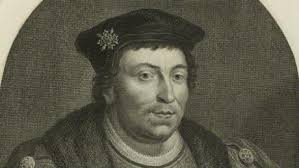The first serious threat to Richard III’s kingship came in mid October 1483, just four months after his coronation. It is hard now to properly judge the popular reaction to the new king and his seizure of power, but the fact that such a real threat came so swiftly points to some disaffection even during the honeymoon period. As Richard was progressing around his new kingdom refusing gifts of money and contenting “the people wher he goys best that ever did prince”, as Thomas Langton, Bishop of St David’s enthused, others were clearly less upbeat about the new king.
When rebellion came, it was famously to involve Richard’s closest and most powerful ally of the last few months, Henry Stafford, Duke of Buckingham. The Duke was to give his name to the uprising, but was this simply an early sleight of hand trick by … well, more on that anon.
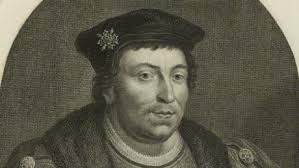
Although Buckingham’s Rebellion would fail it is important to understand just how large and well organised a threat it really was and how fortunate Richard was when it finally broke. It is the nature of regimes, especially new ones seeking to put down roots, that rebellion should be understated, but we should not let that blind us to the size and complexity of what was planned.
The rebellion was to take place on 18th October, St Luke’s Day. It is likely people took less notice of the calendar date than feast days in mediaeval times and it is telling that huge royal events always coincided with feast days. So word would have spread that the Feast of St Luke was the day. Kent was set to rise and attack London from the south east, drawing Richard’s attention that way as men of the West Country, Wiltshire and Berkshire, swelled by Buckingham’s Welsh army crossing the Severn and Henry Tudor’s force of Breton mercenaries landing, probably, in Devon moved in from the west. With Richard’s attention on Kent, they would fall on him, catching him unawares, and bring down the might of their combined dissatisfaction upon him.
But how had Richard come to this so swiftly? In June his coronation had been a triumph. He had been well received all around the country, particularly in the north. Perhaps this is precisely where the problem began. Richard was something of an unknown quantity in London, and after the troubles that seemed barely behind them, few can have looked favourably on more uncertain times and more regime change, especially when this new arrival descended from the north and openly favoured the region. There will come a question of self-fulfilling prophecy to add to the cauldron of confusion.
The mystery of Buckingham’s turning of his coat is as fascinating as it is impossible to solve. He may have fallen out with Richard over the fate of Edward IV’s sons, though even this possibility is sub divided, since Buckingham may have been appalled by a plan outlined by Richard to do away with the boys, or Buckingham may have vehemently argued that it must be done only to be denied by Richard. Perhaps Buckingham saw some revenge against the Woodville clan he had been forced to marry into by killing two of its matriarch’s sons. The sources offer as much weight to a prevailing view that Buckingham had killed the boys as Richard had, and Buckingham had lingered in London for several days after Richard left on his progression. Simply, we have no answer to this, only possibilities that warrant examination.
We do know that Buckingham had long coveted the return of the vast Bohun inheritance, withheld from him by Edward IV. Richard was in the process of restoring this to Buckingham, awaiting only Parliamentary approval, but perhaps this was too slow for Buckingham’s liking and fed a niggling doubt that he would ever get it back.
There are two figures who probably do feature prominently in Buckingham’s defection, and possibly play a role that burrows much deeper into the foundations of Richard III’s rule. This inseparable and unstoppable duo are John Morton, Bishop of Ely and Margaret Stanley (nee Beaufort). I know that much is made of Margaret Beaufort’s involvement or lack thereof in, for example, the fate of the sons of Edward IV, but it remains too little examined for me. I have no doubt that many will take objection to what I offer, but I do not present it as fact, merely as a possible interpretation of what happened. I disagree with the view that Margaret Beaufort could not possibly have been involved in anything that went on as much as I do with the view that she definitely killed the boys.
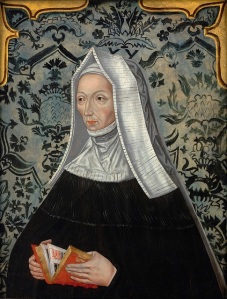
The Tudor antiquary Edward Hall wrote some 60 years later that Margaret Beaufort had chanced to meet Buckingham on the road near Bridgnorth as she travelled to Worcester and he returned to his lands in Wales. She supposedly pleaded with Buckingham to intercede with Richard on her behalf, to use his influence to secure the safe return of her son and his marriage to a daughter of Edward IV, an arrangement that had been close to fruition when Edward suddenly died. There is little of rebellion herein, except that, if this discussion ever took place, Margaret was making it clear to Buckingham that Richard was not one who seemed willing to deliver what had been hoped for under Edward, sowing seeds of doubt that Richard would deliver anything. Of little consequence to Buckingham, perhaps, but he was still hoping for those Bohun lands.
If a seed was sown, it was keenly tended by Bishop Morton when Buckingham reached Brecon Castle. The Bishop had been released from the Tower following the events surrounding Hastings’ execution into Buckingham’s care under a gentle form of house arrest. Morton was mentor to a young Sir Thomas More and it seems likely that More’s version of Richard stems from Morton, a man who seems to have hated Richard with a passion. An ardent Lancastrian, Morton had been reconciled to Edward IV’s rule after Tewkesbury and the death of the line of Lancaster. Buckingham’s family had been staunch Lancastrians too, his grandfather dying at the Battle of Northampton fighting to protect Henry VI. Morton apparently tugged at latent Lancastrian sympathy, perhaps even giving Buckingham hope of the throne for himself. The seed was fertilised and shooting. The Bishop must have been pleased with his work.
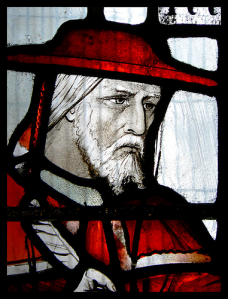
This is where many will disagree with my suggestion, but I think it is possible that more cultivating was going on in London at the same time. Margaret Beaufort wanted her son back. She seems to have decided that he would return best by seizing upon the discontent that bubbled around Richard to make himself king. I don’t subscribe to the view that she spent his entire life plotting to make him king, only that she desperately wanted him back and saw an opportunity to good to miss. An all or nothing gamble. But if she was going to gamble her precious only son, she would need to swing the odds as far in his favour as possible.
It is known that Margaret opened a channel of communication to Elizabeth Woodville in her sanctuary in Westminster Abbey. Unable to risk personal visits, Margaret’s physician, Dr Lewis Caerleon acted as a go between, serving Elizabeth as her physician too. By this medium a pact was reached. Elizabeth Woodville would call out her family’s support and, far more importantly, her late husband’s loyal followers, in support of Henry Tudor’s bid for the throne in return for an assurance that Henry would marry her daughter Elizabeth, making her queen if he were successful.
This is a momentous moment in 1483. It marks the acceptance by Elizabeth Woodville that her sons’ cause was dead, and probably her acceptance that they were dead too. She must have been certain of this to offer all of the support she could ever muster to another claimant to what she would have viewed as her son’s throne. Surely she would only do this with certain knowledge of their death. How did she come by this knowledge? Since it was not known throughout London and the country what had become of the boys, and still isn’t to this day, she clearly had ‘information’ we do not. Where did this information come from? It seems likely to me that the source was Dr Lewis Caerleon, passing on sad news from Margaret Beaufort. This does not mean I’m accusing Margaret of doing the deed, or of having it done (though I don’t think that’s as impossible as many like to make out). I am suggesting that she saw an opportunity to improve her son’s chances by feeding a story to a desperate, lonely mother in sanctuary, starved of information and desperate for news of her son. What would better turn the former queen and all of the Edwardian Yorkist support against Richard than news of the death of her sons whilst in his care? The suggestion was probably more than enough.
There, I said it! Margaret lied to Elizabeth Woodville about her sons to secure her support.
As the Feast of St Luke approached, the rebellion looked in good shape. It was large and was a very, very real threat. But then it began to fall apart. The rebellion relied too heavily on everything going to plan. When a spanner was thrown into the works, the carefully constructed machine fell apart. That spanner was thrown when some of the rebels in Kent showed their hand too early. They marched on London on 10th October for some unknown reason, eight days too early. John Howard, Duke of Norfolk, Richard’s loyal friend, was in London. He swiftly saw off the rebels, capturing enough of them to get details of the rebellion planned for the following week.
Richard III was at Lincoln when news reached him on 11th October of the false start, and of the rest of the plan. He called a muster at Leicester and set out to crush the rest of the waiting rebels. Orders were sent for bridges over the Severn to be destroyed to prevent Buckingham from leaving Wales and the border region was ordered to resist any attempt by Buckingham to cross it.
On 18th October, the plan swung into action, but the weather now seemed to work in the king’s favour, no doubt a sign of God’s favour in the days when men were keen to see signs wherever possible. A tremendous storm battered England. It rained for ten solid days. The River Severn was swollen and ferocious, bursting its banks at many points. With bridges slighted, Buckingham could find no crossing and his less than keen Welsh levies were happy to desert him in favour of home and hearth.
In the Channel, Henry Tudor’s fleet had been scattered by the same storm. When his ship, possibly alone, at most with one other left for company, finally reached the south coast, he was hailed by a group of soldiers as a victorious conqueror. Buckingham had, they called from the shore, succeeded in full and now keenly awaited Henry’s arrival. Ever astute and suspicious, it is not hard to picture Henry narrowing his eyes in the driving rain just off the coast. If it sounded too good to be true, it probably was. Henry turned his ship about and aimed it back at Brittany. His shrewd caution doubtless saved his life.
Buckingham was forced to flee, taking refuge in the house of one of his men, Ralph Banastre. Before long, the promise of a hefty reward caused Banastre to hand Buckingham over to Sir James Tyrell, who escorted the Duke to Salisbury. Buckingham supposedly begged for an audience with his erstwhile friend the king. Richard resolutely refused to allow the Duke into his presence. The feeling of betrayal was plain when, at news of Buckingham’s part in the rebellion, Richard wrote from Lincoln to John Russell, Bishop of Lincoln, requesting that he send the Great Seal, raging in his own hand against “the malysse of hym that hadde best cawse to be trewe, th’Duc of Bokyngham, the most untrewe creatur lyvyng”, adding that “We assure you ther was never false traytor better purvayde for”. To a man who seems to have seen things in black in white, this betrayal of trust was utterly unforgivable. Though this facet of Richard’s character was to cause him great problems in other ways, it probably served him well in this case. Buckingham was beheaded as a traitor in Salisbury market square on 2nd November.
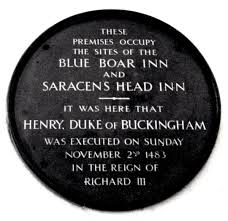
So, it seemed, Richard had swiftly, decisively and effectively crushed the first uprising against his rule. Buckingham was dead. Tudor had scurried back to Brittany, though evaded capture. It was clear that Morton and Margaret were heavily involved in the plot, and it must have seemed as though God had sent the storms to thwart Richard’s enemies, proving that he was the true king, chosen by God.
How Richard dealt with the aftermath of this rebellion was to be key. And I think that he dealt with it poorly.
Morton escaped, fleeing first to the Fens and then taking a ship to Flanders where he hid from Richard’s vengeance and continued to plot. Margaret Beaufort, though, was cornered. Richard’s response to her part in the scheme to place her son upon his throne is remarkable, particulary for those who view Richard as a merciless, ruthless tyrant. Margaret was, in effect, let off. Her lands were forfeit, but were granted to her husband, Thomas Stanley, the same man Richard had arrested as a traitor in June. She was placed under house arrest in her husband’s care. He was to make sure that she made no contact with her son. I can’t imagine what assurances Stanley offered to make Richard believe that he would do as instructed. It was Richard’s mercy, and perhaps naivety, that sealed his fate. Beheading women would have to wait for the Tudor era.
My suggestion is that from the very outset of Richard’s rule, Margaret Beaufort spied an opportunity. If she could not have her son returned to her by peaceful means, then she would craft for him the opportunity of the grandest possible return to England. Perhaps she fed Elizabeth Woodville lies to make her believe that Richard had killed her sons, whether Margaret was aware of their true fate or not. The revelation of the truth could then be what drew Elizabeth and her daughters from sanctuary to Richard’s court a few months later. Whether that revelation was of her sons’ murder at the hands of another, perhaps Buckingham, or of their survival we cannot know, but this version of events at least helps to make her actions more understandable.
This is to view Buckingham’s rebellion as a thin veil drawn over a Tudor plot. His name given to protect others because his life was lost. The extent of these roots may be larger than we know and stretch right back to the very beginning of Richard’s rule. How much of the disaffection against Richard in the south was stirred up deliberately, planting and cultivating opposition to Richard in order to reap support for Henry? It took two years longer than hoped, but the harvest came in finally.
Opposition to and resentment of Richard’s rule only grew when he reacted to the south’s revolt by planting his loyal northern allies across the south. This is perhaps the self-fulfilling prophecy that I mentioned earlier. If men feared Richard would force his northern friends into their region, they made it a certainty by rebelling. If Margaret had used this fear to ferment opposition, Richard played into her hands by doing precisely what the southern gentry feared most – taking their land, money and power away from them. But what choice was Richard really left with? Already, he was being forced to paint himself into a lonely corner. I just wonder how much of this was some overarching Tudor scheme.
I remain unsure whether the sleight of hand here was the work of Richard, to disguise Tudor’s threat, making Buckingham the prime mover and demonstrating his fate, or that of Margaret Beaufort, Thomas Stanley and Henry Tudor, concealing the threat they still hoped and intended to pose.
Ricardians will lament the missed opportunity to remove Stanley in the Tower in June and Margaret following this uprising in October. Without their driving force, determination and resources, would Tudor ever have reached England again? It is testament either to Richard’s naivety, their cunning, or both that they survived to see him fall at Bosworth two years later.
Matthew Lewis is the author of a brief biography of Richard III, A Glimpse of King Richard III along with a brief overview of the Wars of the Roses, A Glimpse of the Wars of the Roses.
Matt has two novels available too; Loyalty, the story of King Richard III’s life, and Honour, which follows Francis, Lord Lovell in the aftermath of Bosworth.
The Richard III Podcast and the Wars of the Roses Podcast can be subscribed to via iTunes or on YouTube
Matt can also be found on Twitter @mattlewisauthor.
